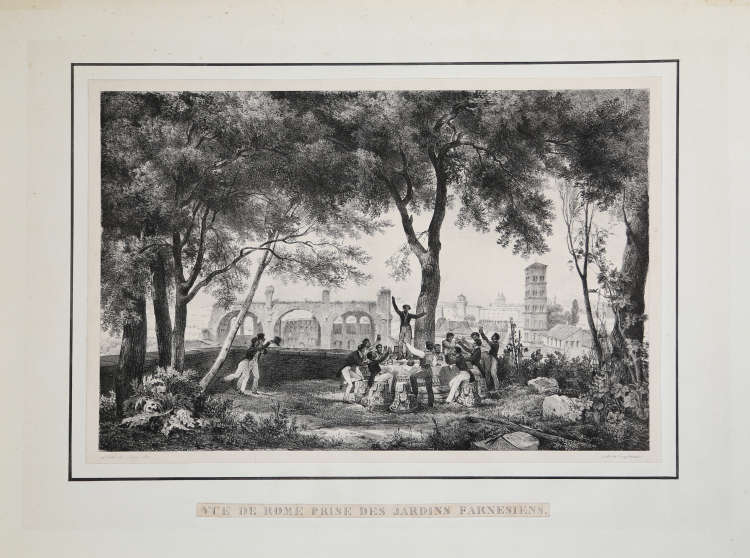


| Reference: | S10211 |
| Author | Godefroy ENGELMANN |
| Year: | 1828 |
| Zone: | Orti Farnesiani |
| Printed: | Paris |
| Measures: | 460 x 320 mm |


| Reference: | S10211 |
| Author | Godefroy ENGELMANN |
| Year: | 1828 |
| Zone: | Orti Farnesiani |
| Printed: | Paris |
| Measures: | 460 x 320 mm |
Lithography in very good condition.
Below the title.
On the left, the signature of the designers and the year of creation "Alaux et Lesueur 1826", on the right the signature of the realizer of lithography.
Godefroy ENGELMANN (1788 – 1839)
|
Godefroy Engelmann (Mulhouse, August 17, 1788 - Mulhouse, April 25, 1839) was a French lithographer. He was born into an old family that had given two burgomasters to the city of Mulhouse. At the time of his birth the City was a small German republic associated with the Helvetic Confederation, but ten years later, in 1798, it was annexed to France. Engelmann initially studied in Switzerland and France, in La Rochelle and Bordeaux, then moved to Paris to study drawing and painting, at the atelier of Jean-Baptiste Regnault. In the summer of 1814 he worked in Munich to learn lithography, which was a German invention, as well as drawing and lithographic art. A year later he founded the "Mulhouse Lithographic Society" in his city, later also opening a workshop-laboratory in Paris. Engelmann was one of the main artists, along with Louis-François Lejeune, who introduced lithography to France. He also developed numerous technical refinements, such as the lithographic watercolor in 1819 and, most importantly, the invention of chromolithography, also in 1819, which was later perfected by other pioneers of this expressive technique, such as the Austrian Peter Fendi. For chromolithography in particular, Engelmann also obtained a patent in England.
During his career he produced a great many prints, but he always had a broader and more far-sighted view of his business. Indeed, he was the originator of the "Société Industrielle de Mulhouse" (SIM), the idea for which he launched as early as 1812. But Engelmann's work was not only applicative. He published important theoretical and didactic texts, such as, "Complete Course of Drawing Study" in 1816, "Manual of the Lithographic Designer" in 1822, and "Theoretical and Practical Treatise on Lithography" in 1839. He also became known as a miniaturist and drew a series of numerous plates for Baron Isidore-Justin Séverin Taylor's, a well-known collector of lithographic art, entitled "Voyages pittoresques et romantiques dans l'ancienne France." Engelmann passed away in Mulhouse at the age of 51, from a tumor in his neck, and his "Printing Company" that he had founded in Paris, under the name "Engelmann et Graf," passed to his son Godefroy Engelmann II, born in 1819, who continued his father's business while maintaining the same technical and artistic quality, until he died in 1897.
|
Godefroy ENGELMANN (1788 – 1839)
|
Godefroy Engelmann (Mulhouse, August 17, 1788 - Mulhouse, April 25, 1839) was a French lithographer. He was born into an old family that had given two burgomasters to the city of Mulhouse. At the time of his birth the City was a small German republic associated with the Helvetic Confederation, but ten years later, in 1798, it was annexed to France. Engelmann initially studied in Switzerland and France, in La Rochelle and Bordeaux, then moved to Paris to study drawing and painting, at the atelier of Jean-Baptiste Regnault. In the summer of 1814 he worked in Munich to learn lithography, which was a German invention, as well as drawing and lithographic art. A year later he founded the "Mulhouse Lithographic Society" in his city, later also opening a workshop-laboratory in Paris. Engelmann was one of the main artists, along with Louis-François Lejeune, who introduced lithography to France. He also developed numerous technical refinements, such as the lithographic watercolor in 1819 and, most importantly, the invention of chromolithography, also in 1819, which was later perfected by other pioneers of this expressive technique, such as the Austrian Peter Fendi. For chromolithography in particular, Engelmann also obtained a patent in England.
During his career he produced a great many prints, but he always had a broader and more far-sighted view of his business. Indeed, he was the originator of the "Société Industrielle de Mulhouse" (SIM), the idea for which he launched as early as 1812. But Engelmann's work was not only applicative. He published important theoretical and didactic texts, such as, "Complete Course of Drawing Study" in 1816, "Manual of the Lithographic Designer" in 1822, and "Theoretical and Practical Treatise on Lithography" in 1839. He also became known as a miniaturist and drew a series of numerous plates for Baron Isidore-Justin Séverin Taylor's, a well-known collector of lithographic art, entitled "Voyages pittoresques et romantiques dans l'ancienne France." Engelmann passed away in Mulhouse at the age of 51, from a tumor in his neck, and his "Printing Company" that he had founded in Paris, under the name "Engelmann et Graf," passed to his son Godefroy Engelmann II, born in 1819, who continued his father's business while maintaining the same technical and artistic quality, until he died in 1897.
|